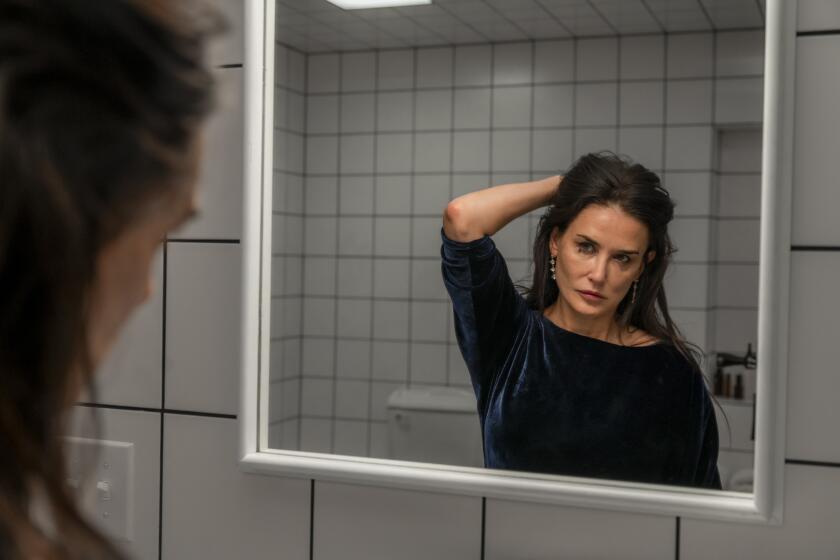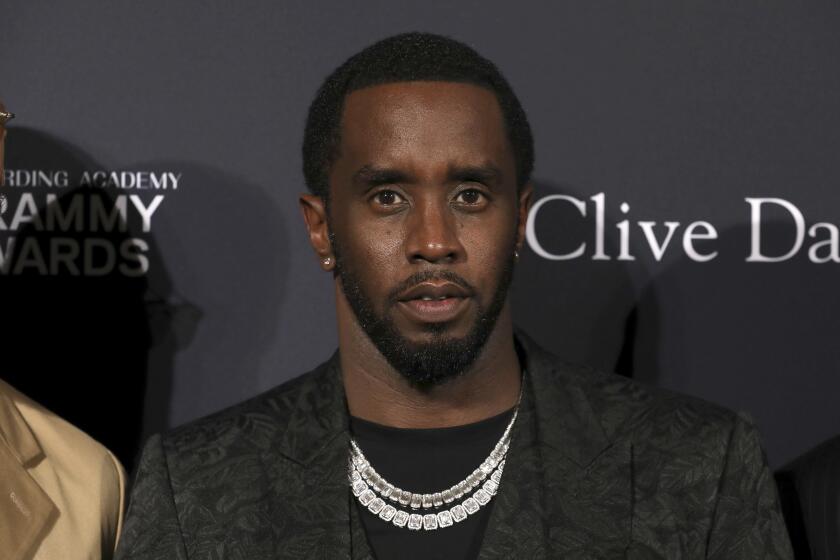Putting a Human Face on ‘It’
After a recent Beverly Hills screening of “The Lord of the Rings: The Two Towers,” members of the Academy of Motion Pictures Arts and Sciences walked out of the three-hour epic buzzing about “him.”
Not actor Viggo Mortensen, who plays the hunky, sword-wielding Aragorn. Not Elijah Wood, cast as the diminutive, ring-bearing hero Frodo. Instead, the chatter focused on Gollum, the wheezing, lisping wretch who plays Frodo’s foil.
What a stunning performance. An Oscar contender. He’s just great!
Technically, Gollum is not a “he,” but an “it” -- an agglomeration of 1s and 0s that required six years of research, scores of computer programmers and countless cycles of processing power to make the animated amphibious creature as believable as human actors.
The key, though, was a human actor -- a classically trained Shakespearean stage player named Andy Serkis whose face never appears on-screen, but nonetheless infuses Gollum with enough sadness and pain to make him perhaps the most believable computer-generated character in a movie.
Animated film characters have mingled on-screen with live actors since Gene Kelly danced with Jerry the Mouse in 1945’s “Anchors Aweigh.” And animators long have been able to squeeze a response out of audiences -- whether it’s the tearful death of Bambi’s mother or the fearful rampage of the Tyrannosaurus rex in “Jurassic Park.”
Yet despite the advances made by powerful computers in animation, most characters have never felt like anything but special effects novelties to humans adept at distinguishing life from lifelike.
Gollum’s debut in “The Two Towers” marks the strongest marriage to date of technology and art in moviemaking. Already, Hollywood is talking about Academy Award nominations both for the team that gave Gollum life and the actor who gave him a soul.
“What’s the difference between John Hurt wearing a latex mask in ‘The Elephant Man’ and Andy Serkis wearing a pixel mask of Gollum now?” asked Russell Schwartz, president of domestic marketing for New Line Cinema, which releases the movie Wednesday. “There’s no difference. They’re both human.”
Making Gollum believable was the biggest technical and artistic challenge for Peter Jackson, who directed “The Lord of the Rings” trilogy. In the J.R.R. Tolkien series on which the movies are based, Gollum is a central figure, a Hobbit disfigured and driven mad by the power of the One Ring.
“Peter’s biggest fear, even back in the earliest days, was that audiences would not think of Gollum as a ‘he,’ ” said Lulu Zezza, a former production supervisor on the “Lord of the Rings” series.
“Peter thought the success of these movies hinged on Gollum being real, being believable,” she said. “If he missed on Gollum, if he didn’t create the hugely dimensional character that he is in the books, the movies would fail.”
The burden fell to Serkis, known for his leading roles in “King Lear” and “Macbeth” at London’s Royal Court Theater. When he met with Jackson and co-producer and writer Fran Walsh in London in the late 1990s, the actor thought he was trying out for a voice-over job.
“My thought was, ‘Why can’t my agent get me up for a decent part?’ ” Serkis said.
The job was quickly clarified. Serkis flew to New Zealand and, for nearly 18 months, joined the rest of the cast in principal photography. That alone was unusual.
When animated characters appear in movies, they are generally added after the fact by technicians and artists. A crew member may read lines or go through the motions to give actors a point of reference. But for director Jackson, there was never a question of using someone other than the person cast in the role of Gollum.
That decision added time and money to the project, but Jackson’s reasoning was that stunt people and crew members don’t have the same ability as actors to speak with their bodies and convey emotion through something as simple as a stare. Serkis’ performances during the original shoot became the foundation of what audiences see on screen.
Each scene that included Gollum was shot at least twice during principal photography, when most of the film is shot. The first time was with Serkis in front of the camera with his fellow actors so they could create an emotional energy and give key data to the lighting and animation teams.
On the second round, Serkis stepped off-camera and the scene was reshot, giving the effects crew a “clean” pass of the scene and space to put in the digital creature.
As the rest of the cast returned home, Serkis stayed in New Zealand and donned a motion-capture suit, acting out for the third time every scene in front of a blank screen.
The suit looks like a wetsuit fitted with dozens of sensors tied to a computer.
When Serkis moved, an electronic skeleton parroted each motion precisely.
The monitoring also covered his face, which was dotted like a pox. Each twitch, smile or grimace was recorded digitally.
During the process Jackson made a decision that threw everything into chaos: Gollum should resemble Serkis.
The edict came as a shock. Artists at Weta Digital had spent years laboring over Gollum’s look, creating so many statues of the emaciated being that they filled one room and threatened to spill into the hallway.
Scrambling to satisfy Jackson, mounds of clay were carved to marry Serkis’ face with the froglike appearance of Gollum. One day, Richard Taylor, head of the practical effects house Weta Workshop, brought a sculpture to Jackson for review.
When Jackson said the ears were too pointy, Taylor reached for a bread knife and hacked down the tips. Moments later, Serkis entered the room.
“It was like seeing my father and my son in the same face,” Serkis said. “It was uncanny.”
The sculpted body and face were scanned into the computer to create a three-dimensional map that became the canvas artists used to link Serkis’ recorded expressions to Gollum’s face. Serkis’ smile became Gollum’s.
Then, it was time to test the system. Serkis and the animators spent days together in darkened rooms studying a monitor, pretending they were sitting in stadium seats at the local multiplex. What would movie-watchers believe? What flaws would they spot?
“In the human brain, we are very sensitive to human faces,” said Henrik Wann Jensen, an assistant professor of computer science at UC San Diego, who has done extensive research in the process of creating realistic human skin. The production team relied on Jensen’s theories in part to develop the look of Gollum’s skin.
“If you look at animals, you can distinguish between a few of them,” Jensen said. “But our brain is encoded to remember hundreds and hundreds of human faces.”
In judging digital characters, one of the first things audiences look for is emotion, said Rob Coleman, animation director at visual effects giant Industrial Light & Magic.
“Do I believe in the character?” Coleman said. “Is there spark behind the eyes? Can I feel that this character is thinking?”
To get an audience to answer yes, animators have to re-create a mind-numbing amount of detail.
“When you talk with someone, you can tell whether they’re engaged or distracted,” Coleman said. “Just a flicker of muscle and we can tell whether someone is telling the truth.”
As for movement, gestures aren’t the only things that must be re-created. Animators also have to duplicate tiny tremors, twitches and tics.
To make a character believable requires “quick twitchy movements [that are] not essential to the performance. It’s a twist of the mouth, a flicker of the eyes,” said Steve Sullivan, research and development director at ILM. “They’re not essential, but they make you realize that the character is in an environment and is reacting to the world beyond the camera.”
One of the biggest tests of this subtlety is seen during Gollum’s three-minute monologue, where the evil creature created by the One Ring has an impassioned debate with his gentle side -- the being known as Smeagol. It is a key point in the film, and a scene where the virtual character literally stands alone in front of the camera.
Back and forth, back and forth, the debate rages. At first, it appears that there are two creatures: The manic Gollum, whose face crinkles with malevolence, and the gentle Smeagol, whose slow movements seem weighed with sadness.
Then, the camera pans back, revealing that the two creatures are actually one. Gollum’s eyes widen. His chest heaves.
Suddenly, he freezes.
For Serkis, the key to making Gollum human was capturing this sense of stillness -- to convey emotion and movement, while remaining absolutely motionless.
“On stage, you use movements to build energy and use stillness to draw the audience in,” Serkis said.
“When I was on stage [against the blue screen], the same theories applied as if I was on stage in London.”
Animators, though, work in a world of movement. To be still is to be flat, uninteresting or worse -- clearly fake. One of the hardest aspects of the role, Serkis said, was thinking like an animator.
“By the end, the animators were more my family than the acting community,” Serkis said.
More to Read
The biggest entertainment stories
Get our big stories about Hollywood, film, television, music, arts, culture and more right in your inbox as soon as they publish.
You may occasionally receive promotional content from the Los Angeles Times.










